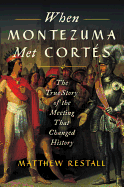
 In When Montezuma Met Cortés, Mesoamerican scholar and historian Mathew Restall dismantles the 500-year traditional story of the "Conquest of Mexico." He begins his history in 1519, with the meeting of the Aztec leader and Spanish conquistador in Tenochtitlan, the sophisticated island capital of the Aztec Empire, now the sprawling metropolis of Mexico City.
In When Montezuma Met Cortés, Mesoamerican scholar and historian Mathew Restall dismantles the 500-year traditional story of the "Conquest of Mexico." He begins his history in 1519, with the meeting of the Aztec leader and Spanish conquistador in Tenochtitlan, the sophisticated island capital of the Aztec Empire, now the sprawling metropolis of Mexico City.
The traditional story is one "in which civilization, faith, reason, reality and a progressive future are victorious over barbarism, idolatry, superstition, irrationality, and retrogressive past." It is built on a self-serving second letter from Cortés to Spain's King Carlos V (the first letter was lost), a questionable translation of Montezuma's address to Cortés and a subsequent slew of historical and literary embellishments. In short, this historic meeting stands as a symbol of the whole history of European colonization of the Americas--the United States included.
Restall debunks what he calls "mythistory." He also questions its dependence on a dubious historical process that ignores the fact that "history is encounter... the sum of all the narratives of those encounters." To transform events into a single interpretation is to create "an appealing tale to mask the unappetizing mess that is reality." A Penn State professor of colonial Latin American history and a prolific author, Restall (The Conquistadors) knows his Mexican history and is sufficiently fluent in a half-dozen languages to do his own translating of primary sources.
When Montezuma Met Cortés digs deep into the details of 16th-century exploration and imperialism (including 150 pages of footnotes and bibliography), but it also rolls along easily with Restall's colloquial asides and skeptical common sense. For example, while Cortés and his Spanish apologists paint him as a loyal heroic soldier with a gift for strategy and diplomacy, Restall uncovers evidence that he was a middling sailor, mediocre leader and voracious womanizer. (This could perhaps describe most of the conquistadors--a peccadillo of those attracted to the life.) Cortés got rich from his years in Mexico, but he built that wealth "with such duplicity, avarice, and self-righteousness that he spent the rest of his life fighting lawsuits, official investigations, and accusations of all kinds."
Similarly, Montezuma was not the submissive sycophant portrayed in the first meeting with Cortés, but rather a shrewd leader checking out his adversaries. As Restall suggests: "Montezuma was not afraid of the Spaniards; he was hunting them." But regardless of the real nature of that historic meeting, the result was a barbaric war with massive casualties on both sides. The ultimate fall of the indigenous empires of the Americas led to their "mass enslavement, sexual exploitation, forced conversion, and subordination as pacified residents." Restall acknowledges that the historical details are ambiguous, but "those blurred lines are not just an issue that historians must tackle; they are History." When Montezuma Met Cortés is a fine example of that kind of history--blurry lines and all. --Bruce Jacobs, founding partner, Watermark Books & Cafe, Wichita, Kan.
Shelf Talker: In When Montezuma Met Cortés, a heavily researched, spirited history, Latin American scholar Matthew Restall reshapes the Spanish-Aztec story.

